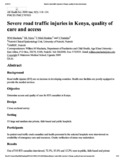| dc.contributor.author | Macharia, W M | |
| dc.contributor.author | Njeru, E K | |
| dc.contributor.author | Muli- Musiime, F | |
| dc.contributor.author | Nantulya, V | |
| dc.date.accessioned | 2013-02-25T09:47:18Z | |
| dc.date.issued | 2009-06 | |
| dc.identifier.citation | Aft Health Sci 2009 June; 9(2): 118-124. | en |
| dc.identifier.uri | http://erepository.uonbi.ac.ke:8080/xmlui/handle/123456789/11139 | |
| dc.identifier.uri | http://www.ncbi.nlm.nih.gov/pubmed/19652745 | |
| dc.description | Severe road traffic injuries in Kenya, quality of care and access | en |
| dc.description.abstract | Road traffic Injury (RTI) is a rapidly growing, yet preventable, public health problem worldwide (1-1) that is projected to become the third leading cause of morbidity and mortality by the year 2020~. Road crashes have enormous impact on national economies and represent a major human tragedy. In 1985 alone, motor vehicle
crashes cost United States more than 75 billion US dollarsQ. It has been estimated that there are over 1.18 million road traffic injury related deaths amrually world wide, with 74% occurring in developing countries 1,1. The young and socio-economically disadvantaged tend to experience disproportionately higher RTI fatality rates.8,.2. In East Africa, road traffic crashes are among the top causes of death from ~uries. Fatality from RTI in Kenya is estimated to have increased by 578% between 1962 and 1992, rising from 7.3 to 8.6 per 100,000 population Most of the road traffic crashes occurred on major rural roads and were associated with higher case fatality rate than those occurring in urban areas 10,11. Reports of fatal crashes on roads in Kenya have continued to feature prominently in the local dailies and electronic media in the form of news flashes and editorials.
Despite the public health importance of RTI, there is little, if any, published infurmation on how RTI casualties are handled at the crash scenes, evacuated to health facilities or received and managed at the facilities. This survey was motivated by the need to map out the magnitude of road traffic ~uries in Kenya in order to provide baseline data to policy makers and other stakeholders who may wish to undertake interventions to improve road safety in the country. The aim of this study was therefore, to determine access and quality of health care fur road traffic ~ury (RTI) casualties in Kenya. We also undertook to :find out the extent to which health care facilities in Kenya were prepared to manage RTI emergencies. Since the time when this study was conducted, there have not been any targeted efforts to address this concern in the country. While availability of medical supplies may have some how improved as an indirect result of rising economic growth realized over the last few years, access to care and quality of services are unlikely to have changed much. | en |
| dc.language.iso | en | en |
| dc.title | Severe road traffic injuries in Kenya, quality of care and access | en |
| dc.type | Article | en |
| local.embargo.terms | 6 months | en |
| local.publisher | Nairobi Clinical Epidemiology Unit, University of Nairobi | en |
| local.publisher | AMREF, Nairobi | en |
| local.publisher | Department of Paediatrics and Child Health, Aga Khan University East Africa | en |


